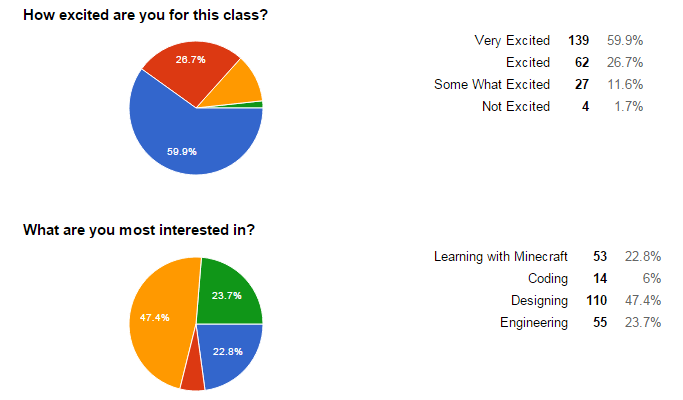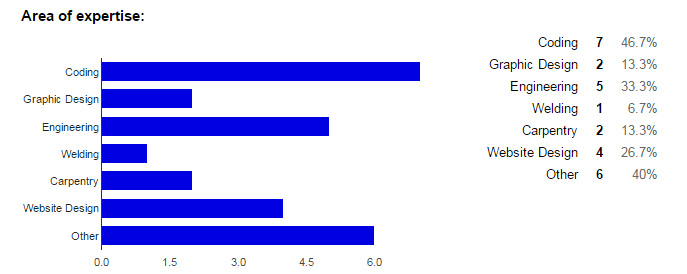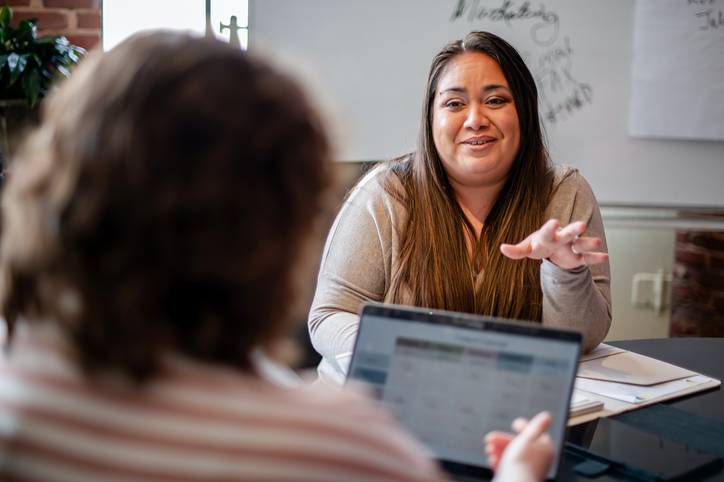First Reflection From the Innovation Labs


We are about a month into Innovation Lab, and even though that may sound like a lot, I only see each class once a week for an hour. In all, since we’ve had some days off since the start of school, I’ve only seen most classes twice. Not a lot, but between observations and collecting data, I’m starting to see some trends. So, in the spirit of the same Growth Mindset I hope my kids develop in the Innovation Labs, here is the first reflection from the trenches of the Innovation Labs.
Sickles Studios, our elementary school Innovation Lab is off to a great start. We take a more whole class and small group approach to tackling Computer Science and Design & Engineering than the more individualized approach we take at the middle school in Knollwood Labs. I’m lucky to work with two super-talented teachers in Sickles Studios and we’ve taken to doing some whole class instruction before breaking into stations for about forty minutes. A month in, and we have second and third graders in Google Classroom with their own accounts while first grade and kindergarten are using a general login. Once online, we started Code.org and I’ve been impressed with how quickly kids are picking it up. We’ve spent the last couple of weeks talking about algorithms and using a great, unplugged activity using paper airplanes to drive the point home. As the kids get better at understanding algorithms, we hope to teach them the types of commands they can give to a program using code. Combined with some Design lessons, we hope to eventually create a garden that is monitored in real-time by a Raspberry Pi the kids will help code. I also just got our radio station (Podcasting) up and running and I’m putting the finishing touches on our TV Station (YouTube) channel, so I’m hoping to have the kids do more inquiry, reflection, and demonstrations as our projects progress.
This is the first year for our Innovation Labs. Knollwood Labs is our middle school offering and will build on what our kids learn in Sickles Studios. Right now, though, Knollwood Labs is starting with nearly 300 5th and 6th graders who have little experience with CompSci and Design & Engineering, but that doesn’t stop them from coming to the Labs excited to learn everyday.

As you can see, kids are pumped for the class. What has also been a pleasant surprise is the diversity of interests kids are bringing to the Lab. You would think a class where learning with Minecraft is possible, it would dominate their interests, but it is Designing that has captured most students attention.
I think I have an explanation for why that is. In the months leading up to the Labs the kids were stoked for Minecraft in school, but as a recovering English teacher, I try to choose my words carefully: In the Labs I let the kids know we learn with Minecraft. How we learn with Minecraft in school is not the same as how we play Minecraft at home. With MinecraftEDU I have turned off the violence, TNT, fire, monsters, and the Netherworld. Many kids were disappointed at first, but many are coming around to the idea of building instead of destroying and more than a few have told me they appreciate the fact that another student can’t come into their world and grief them. It has been shocking, even down the to the kindergarten level, how much kids want to destroy stuff in Minecraft. For now, Minecraft will remain a peaceful place to create. I’m sure there’s some learning that can come from explosions and burning everything to the ground, but I’ve yet to figure it out. I guess some kids just want to watch the world burn.
What may also surprise some is the lack of interest in coding. Only 6% of my kids are most interested in coding (about 60 kids are missing from the survey due to holidays). I think I have an answer to that, too. I think there is some fundamental problems with the way we teach coding in schools and what we expect from our kids. I plan on tackling this in my next post. I am happy to report, though, that a handful of students, about 15, have been brave enough to tackle some real coding. Most have started with Sonic Pi which allows you to code live music and change it instantly by rewriting the code as the music plays on the Raspberry Pi (I’m pitching a Sonic Pi section in the school band!). I’ve also had five brave students either start using Learn to Mod or enroll in Codecademy’s Python coding class.
To further spark my students interest in coding and to improve students’ learning overall, I’ve put out a call to our very talented parent community. Below you can see the responses and where our parent-experts talents are. By inviting parents into the labs, I hope to expose students to different career fields while they learn from parents’ real-world experience.
Tools and ideas to transform education. Sign up below.

I’m proud of the response the labs are getting from the educational community. Last week, the NJ DOE came to see our Labs and the other innovative things going on in our awesome district and they were so impressed with what we’re doing, they’ve asked us to present on Innovation at some upcoming conferences. This week, we are Skyping with Neal Manegold one of the people in charge of Minecraft at Microsoft. In the spring, he and other Minecraft for Microsoft folks hope to stop by the labs in person. I also shared an amazing world one of our students made with them and they are going to feature her work on the Minecraft blog! Additionally, our new friends at Polar 3D have donated a 3D printer to the lab and are looking forward to what the students will create. Google is dropping by soon to let us try out Google Expeditions and we’ve been invited to present at Barnes and Nobles’ Maker Faire, Tech & Learning Magazine’s New York Forum at the end of October, and the Young Innovators Fair in Pennsylvania. The buzz is growing and I’m excited to present with students, show off the great things our kids can do, and show how we can make learning more student-centered and student-driven.
I’m also excited with how well the Fresh Air curriculum is working. The Knollwood Labs site is the actual curriculum for the class. Students come in and begin working right away since everything they need is on the site. They can work at home too if they want. I’m noticing more and more students watching screencasts in the Armory or researching their own answers which frees my partner and I up to work more in-depth with students. This further cements my belief that every teacher should be blending learning. A class website and learning management system have a place in every classroom. On Friday, I shoulder surfed over a girl as she wrote up a Quest that she would like to add to our Quest Map and share with her peers. How cool is that! I’m totally going to add it, I love that kids are starting to make their own Quests to share with each other.
That being said, there’s always room for improvement. I have a few things I’m tightening up in Knollwood Labs. Only 62% of students have completed their first Quest Log — their digital portfolio hosted on Google Sites (using Site Maestro) where they talk about and show evidence of their learning in a two-week clip. I did a demo slam for each class last week, so I’m hoping that will help bring that missing 38% around, but I would have liked to have gotten off to a stronger start. I’ll know for next year to do a more formal, direct instruction in addition to the screencasts. –edit: happy to report that over 90% of students have worked on their Quest Logs now!–
I’m also not thrilled with Heroic Traits. Heroic Traits are the differentiated standards students self-select based on what they learned during a quest. For instance, during a Coding Quest a student might self-select a Heroic Trait that says “I can write a Loop statement in a coding language” as a measurement of learning. I’ve asked students to select three Heroic Traits per Quest, but my kids andI are having a hard time keeping track of which Heroic Traits they’ve chosen. I’m not going to make changes yet, but I’m considering either reducing the Heroic Traits required to one per Quest, scrapping them all together and letting students write their own Heroic Traits for each Quest, or some type of combination of both. Time will tell.
On the Gamification front, I’m torn on leaving up the single player component of the leaderboard or just focusing on the Class vs. Class and Grade vs. Grade aspect, but I think since students can redo their Quest Log until they’re happy with their grade, I’ll let the individual portion stand and see how it goes. I’ve also taken the redos out of the Item Shop where I use to keep them for my high school kids.
I’m worried about the frequency with which some of my kids are changing or finishing their Quests. I know I shouldn’t be. It’s natural for kids this early to want to try out a bunch of different things, but I’m hoping that as the year goes on they’ll focus more on depth instead of breadth.
Sometimes it’s the little things that make a big difference. The biggest little thing that is driving me nuts: storage! Students have flocked to the Deconstructors Raid where, as part of a group, they take apart a device, document and label the parts, and try to put it back together unlocking an achievement if it still works when/if they get it reassembled. Again, I turned to our community for devices to take apart and they’ve been amazing in getting me all kinds of awesome stuff to deconstruct (we built our first working computer from broken ones, this week), but storing the stuff before students work on it and storing it while students are working on it is frustrating. We are working in the back of our library and storage and space in general is tough to come by.
I’ve never been more excited to be an educator. My school, community, and kids are fantastic. I’m excited to continue trying to make our Innovation Labs a national model for student-centered, passion-based learning because while we are teaching “STEM,” any class, anywhere can and should be made into an Innovation Lab and in doing so, I think we’ll provide more authentic, meaningful learning opportunities for our students.
cross-posted at Teched Up Teacher
Chris Aviles presents on education topics including gamification, technology integration, BYOD, blended learning, and the flipped classroom. Read more at Teched Up Teacher.
Chris Aviles is a STEM teacher, edtech specialist, and president of Garden State Esports. He is also a regular contributor to Tech & Learning.
